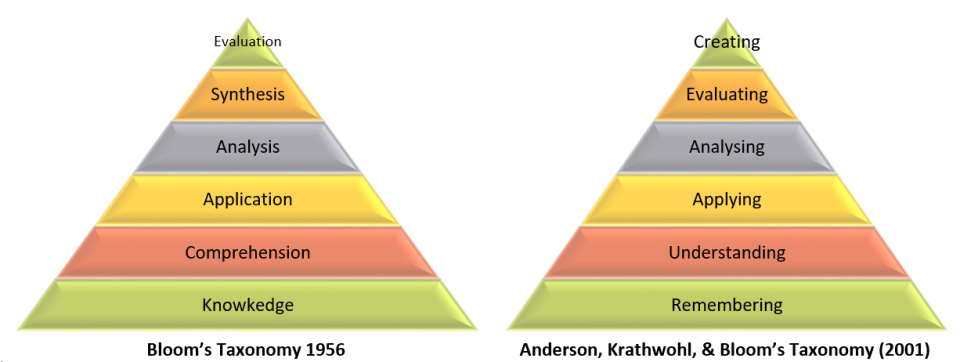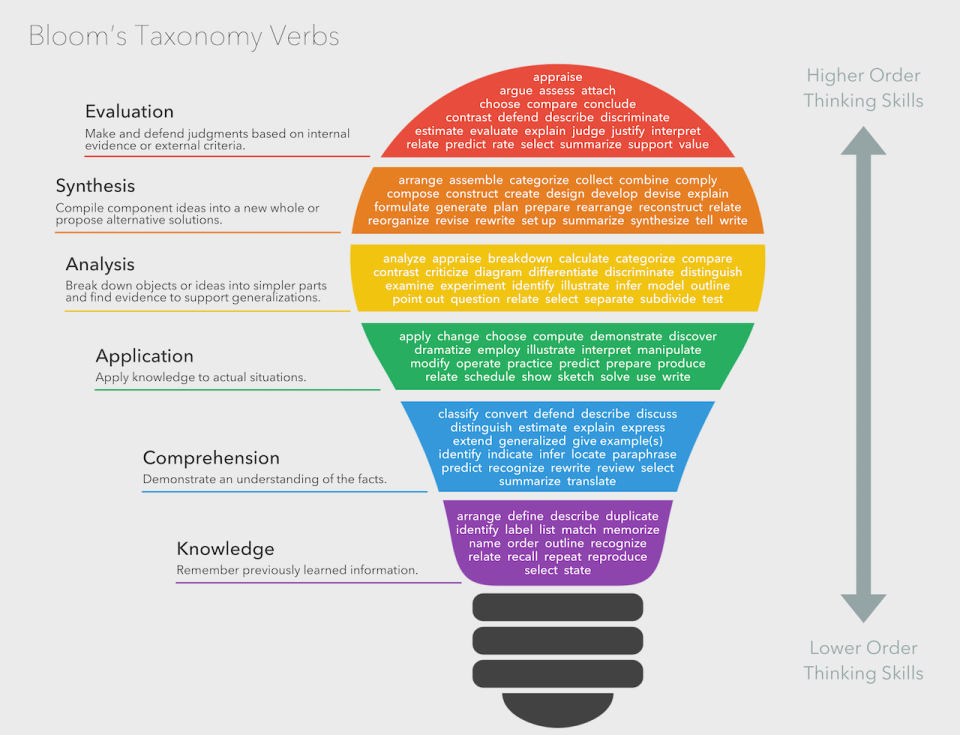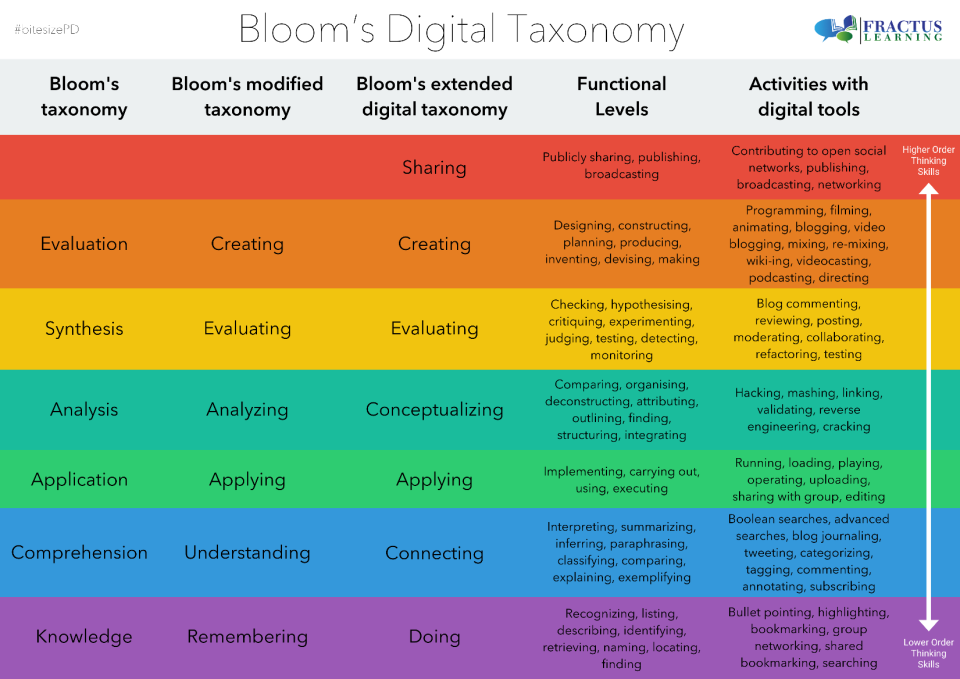By Íde O’Sullivan (Centre for Transformative Learning).
Reading Time: ~5 minutes.
Featured Image Source: SmartArt Graphic created by author.
In this post:
- Introduction
- Bloom’s Taxonomy
- Why use Bloom’s Taxonomy in curriculum design?
- Bloom’s Digital Taxonomy
- Conclusion
Introduction
As we progress through this pandemic and dialogue emerges about teaching in ‘post-Covid’ times, our thoughts turn to reflecting on the delivery of our remote teaching in an emergency situation and to planning the delivery of our modules and programme, new and existing, in blended learning environments. Indeed, it is very likely that our modules and programmes will have a blended or online component moving forward. As we all know, a blended or online approach will only be as good as the educational design guiding that approach. Constructive alignment is central to good educational design.
The learning outcomes which you want your students to achieve upon successful completion of your module, namely, cognitive (knowledge), affective (beliefs, values and attitudes) and psychomotor (skills) learning outcomes, are at the heart of the design of your module. These learning outcomes guide the teaching and learning strategies which you will design in order to help students achieve these outcomes. Equally, the assessment strategies employed will allow you to know if students have achieved these learning outcomes. Indeed, the careful alignment of these components is at the heart of good teaching and constructive alignment:
The fundamental principle of constructive alignment is that a good teaching system aligns teaching method and assessment to the learning activities stated in the objectives so that all aspects of this system are in accord in supporting appropriate student learning.
(Biggs, 1999, p. 25)
Bloom’s Taxonomy
Bloom’s Taxonomy of Educational Objectives has, for many decades, provided a useful framework for creating and deciding upon appropriate activities to engage students in meaningful and deep learning experiences. The framework, divided into three psychological domains (cognitive, affective and psychomotor), is hierarchical in nature and progresses from lower-order thinking skills (LOTS) to higher-order thinking skills (HOTS). The original framework (Bloom, 1956), in particular the cognitive domain, was revised in 2001 (Anderson, Krathwohl and Bloom, 2001) in a move to create a more dynamic classification by using verbs to describe the cognitive processes, revisiting the order of the two highest levels in the domain and remaining some of the levels, as you can see in the diagram below.

When writing learning outcomes, once you have decided on the psychological domain (cognitive, affective or psychomotor), Bloom’s Taxonomy will help you to consider and identify the appropriate level of learning/thinking for your students within that domain. You will then identify an appropriate action verb which describes best what you want your students to do, adding the content and context in which you want the student to perform the action.
For more on writing effective learning outcomes, see Further Reading below.
Why use Bloom’s Taxonomy in curriculum design?
Organising the learning objective according to Bloom’s Taxonomy provides a list of shared objectives that are visible to teachers and students, ensuring that the objectives and expectations are clearly stated to all involved. Student-centered learning outcomes articulated clearly ensure that students know what they will be able to do or what they will know upon successful completion of the module and how they will be able to evidence this through a given assessment.
The usefulness of Bloom’s Taxonomy, however, extends beyond the effective articulation of learning outcomes. The many verb tables that have been developed to help identify the action verbs which align with the different levels of learning within each domain help teachers identify appropriate tasks and activities that align with the learning objectives. Indeed, identification of appropriate action verbs is helpful for the teacher to identify and decide upon appropriate learning tasks/activities which will support and measure attainment, and also for the student to comprehend what tasks/activities they are expected to undertake in order to successfully achieve the outcome. The diagram below lists many of these associated tasks within the cognitive domain.

Bloom’s Digital Taxonomy
In the recent transition to an online learning and teaching environment, Bloom’s Taxonomy, and in particular Churches’ (2008) adaptation to produce Bloom’s Digital Taxonomy, can be extremely helpful in planning digital learning, teaching and assessment tasks and strategies to meet the identified learning outcomes. Bloom’s Digital Taxonomy is an extension of Bloom’s Taxonomy and provides a useful framework for designing learning activities in a digital environment. It expands upon the skills associated with each level, adding new digital action verbs associated with each level, for example, blogging, podcasting and programming. In addition, others have gone a step further to identify digital tools that foster learning at each level, thus producing tables, such as the one outlined below, which align each level of learning with new digital action verbs and identify technologies and digital tools that foster that kind of learning/thinking, thus helping instructors to identify tasks and digital tools to facilitate student learning experiences and outcomes.

Many different versions of this table have been produced. For example:
- https://teachonline.asu.edu/2016/05/integrating-technology-blooms-taxonomy
- The Bloom's Taxonomy Verbs Poster for Teachers – Wabisabi Learning.
An example in practice
Stephanie Smith Budhai outlines a good example here: Leveraging Bloom’s Taxonomy to Elevate Discussion Boards in Online Courses | Faculty Focus
Conclusion
As with any instructional design, it is important to remember that the focus is not on the technology but rather on how the technology can be used to enhance thinking/learning at a particular level, i.e. how the tools and technologies can support different cognitive levels. For example, which tools are suitable to support students’ knowledge and comprehension and which are suitable for creating and sharing? Nonetheless, Bloom’s Digital Taxonomy is extremely valuable in planning digital learning, teaching and assessment tasks and strategies to meet the identified learning outcomes of our modules and programmers.
Supported tools at UL
Consult the wheel of supported tools at UL to see the array of supported tools at UL to support learning, teaching and assessment activities: https://www.ul.ie/ltf/supported-tools.
Further support
ABC Learning Design sessions (https://abc-ld.org/) are a useful way to assist programme teams with the design of learning activities for a blended and online environment. Should your programme team wish to arrange an ABC Learning Design sprint session, please contact Íde O’Sullivan (Curriculum Development Support) at the Centre for Transformative Learning (CTL): ide.osullivan@ul.ie.
About the author
Dr. Íde O’Sullivan is a Senior Educational Developer at the Centre for Transformative Learning, where she is Curriculum Development Support Lead. Íde is leading on the development of a curriculum development framework for UL in close collaboration with the Curriculum Development Framework Working Group. Íde teaches curriculum design and leads three scholarship modules on the Graduate Diploma/MA in Teaching, Learning and Scholarship.
Further reading
For more on writing effective learning outcomes, see CTL’s Tips for Writing Programme and Module Learning Outcomes. These guidelines should be used in conjunction with UL’s comprehensive guide to Writing Learning Outcomes: A Guide for Academics, which is available here: Writing Learning Outcomes at Programme and Module Levels.doc.
Griffith University, Australia has an excellent resource on writing effective course learning outcomes that are SMART (specific, measurable, attainable, relevant, and time-framed): teaching-resources.griffith.edu.au/writing-smart-los/story_html5.html?
In addition, here are some online tools for helping to create learning objectives:
- University of Central Florida’s Objective Builder tool: https://lti.online.ucf.edu/objective-builder
- Arizona State University’s Learning Objective Builder: https://teachonline.asu.edu/objectives-builder
References
Anderson, L. W., Krathwohl, D. R., and Bloom, B. S. (2001) A Taxonomy for Learning, Teaching, and Assessing: A Revision of Bloom’s Taxonomy of Educational Objectives (Complete ed.). New York: Longman.
Biggs, J. (1999) Teaching for Quality Learning at University. Buckingham: SRHE/OU Press.
Bloom, B.S. (1956) Taxonomy of Educational Objectives, Cognitive Domain, McKay, New York, Vol. 1 No. 20, p. 24.
Churches, A. (2008) Bloom’s Digital Taxonomy. Unpublished. http://burtonslifelearning.pbworks.com/w/file/fetch/26327358/BloomDigitalTaxonomy2001.pdf
CTL (2020) Tips for Writing Programme and Module Learning Outcomes.
CTL (2008) Writing Learning Outcomes: A Guide for Academics.